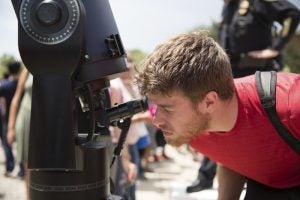The Great American Eclipse will occur on the first day of classes at the University of Central Florida, giving students another big reason to be excited.
It’s the first total solar eclipse visible from the contiguous United States since 1979. The next one won’t occur until April 8, 2024.
A solar eclipse occurs when the sun and moon line up with Earth, with the moon in between. A total solar eclipse, when this alignment is exact, means that a person on Earth in the right place can see the moon completely block out the sun. Part of the reason the total eclipse is so stunning is because the sun and the moon are the same angular size, meaning that although the sun is 400 times bigger than the moon, it’s also 400 times farther away. So the moon just barely will block out the sun in totality, making it appear to be twilight in the middle of the day.
Florida won’t be in the direct path, but NASA will stream video of the entire eclipse. People living south of South Carolina will only see a partial eclipse, but it’s still worth taking a moment to check out, as long as you can do it safely. The Planetary Sciences Group at UCF, the College of Sciences, and the student-run Astronomical Society will host a viewing party 2-3:30 p.m. in front of Millican Hall and the Reflecting Pond to mark the occasion.
Telescopes with special filters will be available for viewers to safely observe the eclipse. Solar glasses also will be available to attendees, and professors and students studying planetary sciences will be on hand to answer questions.

“We wanted to make sure folks here would have the opportunity to see the eclipse,” said physics associate professor and UCF Robinson Observatory director Yan Fernandez. “It will be a partial here, but it will still be pretty spectacular if it doesn’t rain. So even though some of us will be on the road, we wanted to make sure our community had the opportunity.”
Fernandez and several other professors and scientists from UCF will join thousands along the eclipse’s path of totality. That’s a swath that runs from Oregon through Idaho, Wyoming, Nebraska, Missouri, Kansas, Illinois, Kentucky, Tennessee, North Carolina, Georgia, and South Carolina where spectators will be able to observe the eclipse in its totality – for a little more than two minutes.
“It is really impossible to describe, but truly amazing,” said UCF physics professor Humberto Campins, who will stay on campus to help with the viewing event. He traveled to Costa Rica in 1991 and Curacao in 1998 to view solar eclipses. “We hope the weather holds out here, but if you have a chance, go to the path of totality. It really is awe-inspiring experience.”
Most hotels within the path of totality have been sold out for weeks, according to media reports. It’s no surprise to Campins, who said that during his previous trips hotels were sold out months in advance and the internet slowed down to a crawl because of the number of people sharing photos and their experiences on social media.
“I wouldn’t miss it,” said Noemi Pinilla-Alonso, an associate scientist at the Florida Space Institute based at UCF. She specializes in solar-system formation, particularly surface compositions of minor bodies. She will meet scientists from Spain who are flying to Idaho Falls to observe the eclipse. “It will be my first. I can’t wait to see it, you know to see day turn into night and then back into day.”
Scientists nationwide, along with NASA, will study the eclipse. Solar eclipses have been used to test aspects of Einstein’s theory of general relativity. More recently scientists have been studying eclipses to improve the accuracy of measurements of the moon’s orbit and to improve the mathematical model for the gravitational interactions between Earth and the moon.